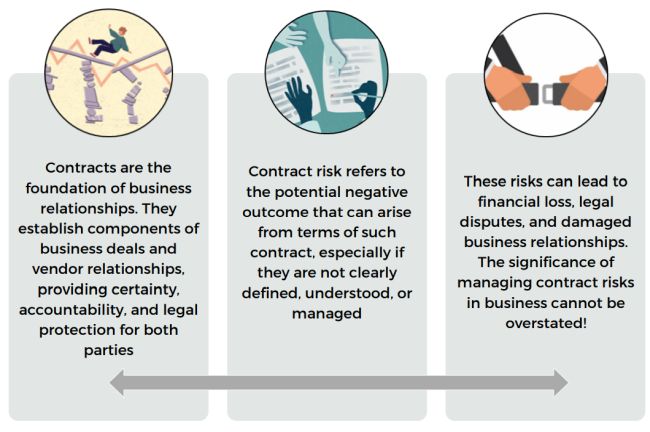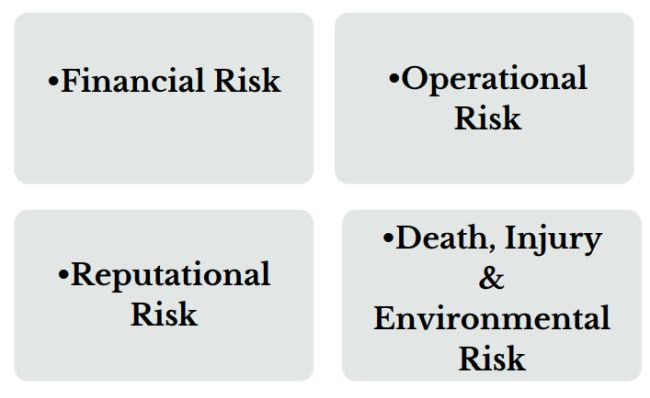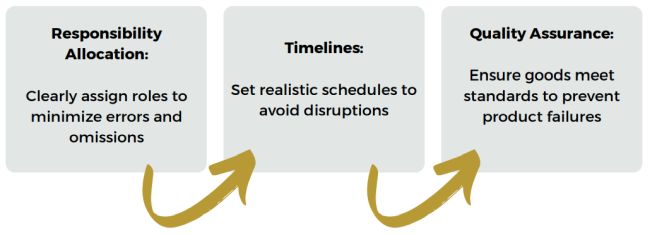Contact Risks
Contract risks are shadows, mitigation is the light that illuminates businesses!

Business Risks in Contracts
- In the dynamic world of business, success relies on the ability to navigate uncertainty. Every venture, regardless of industry or size, faces inherent risks that can disrupt operations, cause losses, and derail progress. Understanding these potential threats and implementing effective mitigation strategies is of great importance for ensuring business continuity and achieving long-term objectives.
- Every business faces inherent risks that can impact its ability to achieve objectives. These risks can be broadly categorized into four quadrants:

Operational Risk
- Running a business is exciting, but unexpected events can throw a jerk in core operations or processes of the business. These "jerks" are called operational risks, and they can be anything from computer crashes to employee mistakes.
- According to the Basel III framework, operational risk is defined as the risk of loss resulting from inadequate or failed internal processes, people and systems or from external events. This definition includes legal risk but excludes strategic and reputational risk.2
- Addressing operational risk is not just about avoiding pitfalls but seizing opportunities while strengthening operations that are the foundation of any business.
IDENTIFYING A FEW OPERATIONAL RISKS, CONSEQUENCES AND MITIGATION FACTORS FROM A LEGAL PERSPECTIVE THAT MAY BE ADOPTED BY THE CORPORATES
RISK 1: OVER COMMITMENT
Business runs like a clock, but sometimes the gears get stuck. There might be various factors that give rise to delays in delivery, like faulty processes, technical failures etc.
- If the contractual commitment does not match from the internal processes followed, there will definitely be a delay. For example, it is known to a manufacturer that the packaging of the product will definitely take 3 days, committing 2 days in a contract is a clear mismatch, which puts the vendor at risk
- Breach of contract and liabilities due to delayed deliveries or defective products may lead to unhappy customers
- As a purchaser, a common remedial clause incorporated in the contract as a consequence for delayed delivery is the clause related to liquidated damages. Liquidated damages will specify the quantum of damages that may have to be paid for every missed milestone or delivery
- As a vendor, the delivery clause needs to be critically examined

The Mitigation Tools
- Contracts should be tailored to suit the transaction, balanced for both the Parties. Any delay impacts both the parties. Thus, realistic delivery schedules may be beneficial for both Parties
- Shaping Your Workforce : An inefficient workforce can significantly disrupt operations. However, well-designed training programs aligned with specific contracts offer a powerful solution. In reality, sometimes, a targeted training to employees will ensure that employees are aware about the commitments and will work towards the same, avoiding a breach of contract
Risk 2: Employee Error
Every business thrives on smooth operations, where people and processes work flawlessly together
- Even the best systems can stumble by a hidden threat like an employee error. It can happen because of inefficient workflow, negligence, or even lack of control etc. that can silently cause problems. For example, if the employee error leads to breach of personal data of a client or a third party wherein parties are governed by GDPR, a huge penalty may be imposed on the organization
- While these issues need detailed analysis and multiple steps at the organization level, one common mitigation step that can be adopted by organization is to have proper trainings
- Further, organizations may also consider obtaining detailed error and omission insurance for covering any errors by its personnel
- Contract should incorporate a disclaimer clause to identify intentional and non intentional error and capping of liability basis the error
One must note that irrespective of detailed contracts, practical trainings and interactive culture within the organization will serve better to reduce employee errors. Openness encourages a collaborative environment where employees feel comfortable sharing ideas and concerns. This allows for early detection and correction of potential errors, preventing them from becoming bigger issues
Risk 3: Internal Fraud
Every business aspires for smooth operations, but a sneaky enemy lurks in the shadows in form of fraud. A fraud by employees or consultants can wreak havoc on your finances, reputation, and overall success
It should be noted that an organization can be held responsible for the fraud committed by its employees, as has been repeatedly held by Courts. Recently, Supreme Court in PRADEEP KUMAR AND ANOTHER VERSUS POST MASTER GENERAL (CIVIL APPEAL NOS. 8775-8776 OF 2016) held that once it is established that fraud or any wrongful act was perpetrated by an employee during the course of their employment, the employer would be vicariously liable for the wrongful act of such employee
To tackle this risk from a legal perspective, you should ensure that the agreement with your employees or consultants is carefully drafted in detail. More on employment agreements can be read here. Typically, you should cover meticulous clauses to obtain:
Risk 3: Internal Fraud
- Indemnities. To obtain reimbursement of all damages suffered by the organization in case of any fraud
- Equitable Remedies: You should be entitled to invoke urgent equitable remedies like injunctions to halt ongoing fraud or asset freezes to prevent further financial harm
- Further, you should implement clear mechanism to report concerns freely by the employees and have a proper Whistle Blower policy that may encourage employees or third parties to report suspicious activity sooner to avoid being implicated in the fraud and facing the penalty
- Strict checks and balances to be maintained to regularly caution and train the employees for better internal processes
Risk 4: External Factors
- Force Majeure as a Shield:
Beyond internal processes and people, a different kind of threat lurks i.e. external errors. From natural disasters to unexpected political shifts, these unforeseen events can disrupt operations and cause significant losses.
The best-laid plans can be disrupted by unforeseen circumstances. This is where force majeure comes in – a contractual clause acting as a shield against external errors. The force majeure clause needs to be carefully deliberated to include industry specific factors that may affect operations of your sector. For example, if the raw material necessary for manufacturing goods are available only in a specific territory, then specific reference of factors affecting such territory need to be adopted. Think of it as a safety net that may excuse a party from certain obligations due to events beyond their control, like natural disasters or political upheaval.
- Insurance clause in the contract:
The insurance clause outlines specific coverage requirements for the insuring party, mitigating operational and financial risks associated with the agreement and providing reassurance to parties who have opted for insurance.
Risk 5: Breaches by Sub-contractors
- Subcontracting and outsourcing is a common business practise in today's interconnected world. However, in case your sub-contractor commits a breach of its commitments, it may result in huge liability on you, if the end customer suffers a damage
- A conscious decision on subcontracting should be taken wherein dependability on such sub-contractors should be considered thoroughly
- Detailed sub-contracting arrangements with a back-to-back scope should be executed. Further, an open-ended clause for last–minute client requirements could be incorporated which may give you a window to flow-down such requirements of the clients on to sub-contractors
- Bank guarantee can be obtained from sub-contractors
Conclusion
- By proactively identifying and mitigating operational risks, businesses can improve their operational efficiency, protect their assets, and ensure longterm success
- Every business, regardless of industry or size, faces inherent risks that can disrupt operations, cause losses, and break the progress. Understanding these potential threats and implementing effective mitigation strategies is of great importance for ensuring business continuity and achieving longterm objectives
- Equipping workforce with the right tools and training can turn potential disruptions into opportunities for growth
- Along with a well drafted agreement, organizations should take multiple steps like obtaining correct insurance policies, training their employees and adopting proper workplace policies to minimize their risks
Footnotes
1. The article reflects the general work of the authors and the views expressed are personal. No reader should act on any statement contained herein without seeking detailed professional advice.
2. https://risk-officer.com/Operational_Risk.htm
The content of this article is intended to provide a general guide to the subject matter. Specialist advice should be sought about your specific circumstances.
